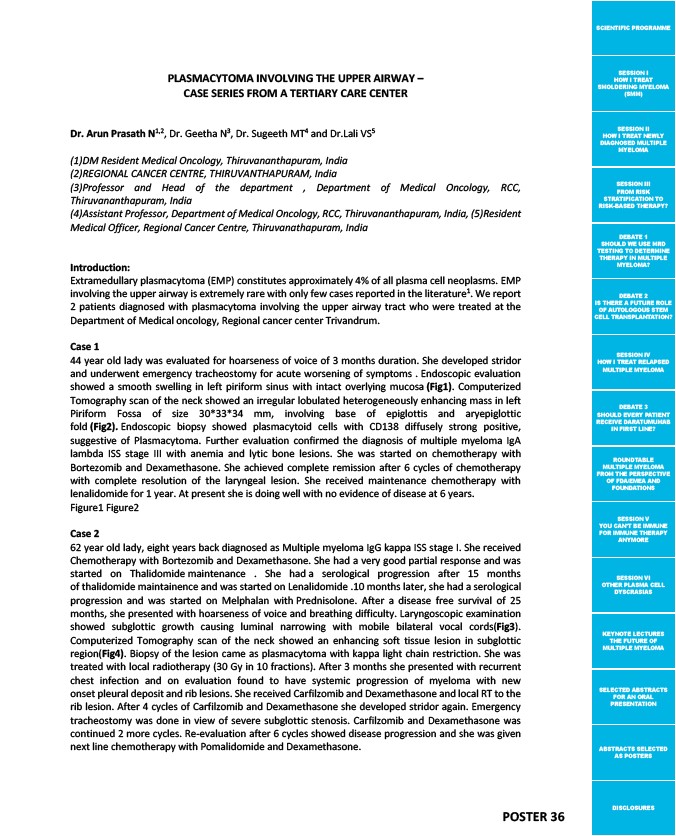
SCIENTIFIC PROGRAMME
SESSION I
HOW I TREAT
SMOLDERING MYELOMA
(SMM)
SESSION II
HOW I TREAT NEWLY
DIAGNOSED MULTIPLE
MYELOMA
SESSION III
FROM RISK
STRATIFICATION TO
RISK-BASED THERAPY?
DEBATE 1
SHOULD WE USE MRD
TESTING TO DETERMINE
THERAPY IN MULTIPLE
MYELOMA?
DEBATE 2
IS THERE A FUTURE ROLE
OF AUTOLOGOUS STEM
CELL TRANSPLANTATION?
SESSION IV
HOW I TREAT RELAPSED
MULTIPLE MYELOMA
DEBATE 3
SHOULD EVERY PATIENT
RECEIVE DARATUMUMAB
IN FIRST LINE?
ROUNDTABLE
MULTIPLE MYELOMA
FROM THE PERSPECTIVE
OF FDA/EMEA AND
FOUNDATIONS
SESSION V
YOU CAN’T BE IMMUNE
FOR IMMUNE THERAPY
ANYMORE
SESSION VI
OTHER PLASMA CELL
DYSCRASIAS
KEYNOTE LECTURES
THE FUTURE OF
MULTIPLE MYELOMA
SELECTED ABSTRACTS
FOR AN ORAL
PRESENTATION
ABSTRACTS SELECTED
AS POSTERS
DISCLOSURES POSTER 36
PLASMACYTOMA INVOLVING THE UPPER AIRWAY –
CASE SERIES FROM A TERTIARY CARE CENTER
Dr. Arun Prasath N1,2, Dr. Geetha N3, Dr. Sugeeth MT4 and Dr.Lali VS5
(1)DM Resident Medical Oncology, Thiruvananthapuram, India
(2)REGIONAL CANCER CENTRE, THIRUVANTHAPURAM, India
(3)Professor and Head of the department , Department of Medical Oncology, RCC,
Thiruvananthapuram, India
(4)Assistant Professor, Department of Medical Oncology, RCC, Thiruvananthapuram, India, (5)Resident
Medical Officer, Regional Cancer Centre, Thiruvanathapuram, India
Introduction:
Extramedullary plasmacytoma (EMP) constitutes approximately 4% of all plasma cell neoplasms. EMP
involving the upper airway is extremely rare with only few cases reported in the literature1. We report
2 patients diagnosed with plasmacytoma involving the upper airway tract who were treated at the
Department of Medical oncology, Regional cancer center Trivandrum.
Case 1
44 year old lady was evaluated for hoarseness of voice of 3 months duration. She developed stridor
and underwent emergency tracheostomy for acute worsening of symptoms . Endoscopic evaluation
showed a smooth swelling in left piriform sinus with intact overlying mucosa (Fig1). Computerized
Tomography scan of the neck showed an irregular lobulated heterogeneously enhancing mass in left
Piriform Fossa of size 30*33*34 mm, involving base of epiglottis and aryepiglottic
fold (Fig2). Endoscopic biopsy showed plasmacytoid cells with CD138 diffusely strong positive,
suggestive of Plasmacytoma. Further evaluation confirmed the diagnosis of multiple myeloma IgA
lambda ISS stage III with anemia and lytic bone lesions. She was started on chemotherapy with
Bortezomib and Dexamethasone. She achieved complete remission after 6 cycles of chemotherapy
with complete resolution of the laryngeal lesion. She received maintenance chemotherapy with
lenalidomide for 1 year. At present she is doing well with no evidence of disease at 6 years.
Figure1 Figure2
Case 2
62 year old lady, eight years back diagnosed as Multiple myeloma IgG kappa ISS stage I. She received
Chemotherapy with Bortezomib and Dexamethasone. She had a very good partial response and was
started on Thalidomide maintenance . She had a serological progression after 15 months
of thalidomide maintainence and was started on Lenalidomide .10 months later, she had a serological
progression and was started on Melphalan with Prednisolone. After a disease free survival of 25
months, she presented with hoarseness of voice and breathing difficulty. Laryngoscopic examination
showed subglottic growth causing luminal narrowing with mobile bilateral vocal cords(Fig3).
Computerized Tomography scan of the neck showed an enhancing soft tissue lesion in subglottic
region(Fig4). Biopsy of the lesion came as plasmacytoma with kappa light chain restriction. She was
treated with local radiotherapy (30 Gy in 10 fractions). After 3 months she presented with recurrent
chest infection and on evaluation found to have systemic progression of myeloma with new
onset pleural deposit and rib lesions. She received Carfilzomib and Dexamethasone and local RT to the
rib lesion. After 4 cycles of Carfilzomib and Dexamethasone she developed stridor again. Emergency
tracheostomy was done in view of severe subglottic stenosis. Carfilzomib and Dexamethasone was
continued 2 more cycles. Re-evaluation after 6 cycles showed disease progression and she was given
next line chemotherapy with Pomalidomide and Dexamethasone.